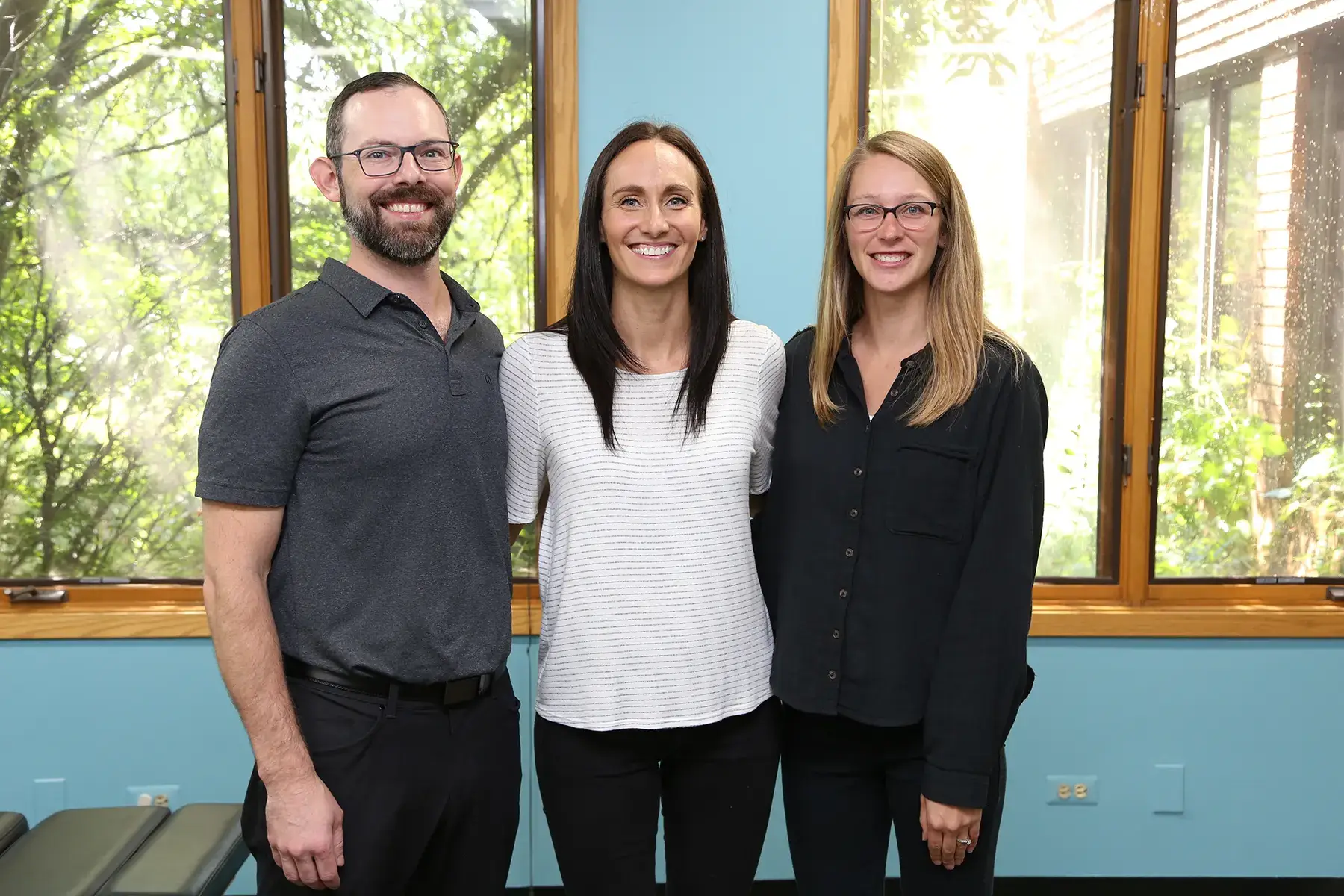
The sciatic nerve is one of the largest in the body, running from the buttocks down the back of the leg. Sciatica is a condition that results in compression of the sciatic nerve causing pain, numbness, and tingling that travels down the back of the leg. Sciatic pain typically worsens with prolonged periods of sitting and improves with movement. Because most people nowadays sit for work for hours on end day after day, sciatica is especially common. Sitting and many other everyday activities, such as lifting, repetitive motions, carrying kids, and golfing, can cause subluxation.
A subluxation is a joint of the spine or pelvis that can’t function properly, which creates stress and pressure on the spinal nerves and commonly results in pain. The three lowest spinal nerves in the lower back (L3, L4, and L5) combine to form the sciatic nerve. Sciatic pain is commonly caused by subluxations in the lower back and pelvis. Additionally, when subluxations are present in the spine, muscles tend to tighten around the area and can contribute to compression of the sciatic nerve and pain down the back of the leg.
Sciatica typically responds well to chiropractic care as we focus on restoring motion in the lower back joints, taking pressure off the nerves, and resolving pain. If left untreated, you may develop worsened pain and weakness in the affected leg. This is why it is crucial to get treatment sooner rather than later.
How We Treat Sciatica Pain in Arlington Heights, IL
Comprehensive Consultation and Exam
We want to be sure that we know exactly what is causing your sciatica pain before recommending any treatment. Treating your sciatica starts with sitting down with one of our doctors, who will really listen to what you have been experiencing. We are always shocked when patients tell us they have never had as thorough of an evaluation with a doctor who truly listens.
Once we have a better idea of what has been going on, we will perform a thorough examination, including palpation of the spine, posture analysis, orthopedic tests, computerized neurological scans, and digital X-rays (if needed).
At the end of the evaluation, the goal is to determine if dysfunction in the spine and nervous system is the root cause of your sciatica pain and to determine the most effective treatment plan.

Specific Chiropractic Care in Arlington Heights, IL
As chiropractors, we treat subluxations. These are joints of the spine that are misaligned or not moving as they should. When this happens, it puts stress and pressure on the nervous system, preventing the nerves from functioning as they should and causing symptoms. Subluxations present within the lower back and the pelvis can result in sciatica. The most common way subluxations occur is through poor posture and repetitive movements.
Chiropractic adjustments are specific movements performed on areas of the spine where subluxations are present. The chiropractic adjustment restores motion in the joints and relieves pressure on the nervous system. This allows your body to heal and function the best it can, resolving your sciatica.
Custom Therapeutic Exercise Plan
When spinal joints are misaligned or not functioning as they should, it can create muscle tightness, weakness, and imbalance in the muscles that attach to the pelvis and the bones of the lower back. For this reason, you will receive a customized therapy plan to be done at home to ensure proper healing. The stretches and exercises we recommend support our adjustments and ensure that the muscles in the glutes and legs don’t add any strain on the sciatic nerve.
Flexion/Distraction
Not only can misaligned or restricted joints create sciatic pain, but it can also arise from problems in the spinal discs – the spaces between the individual bones of the spine. Spinal flexion/distraction is a technique that restores motion into the joints, brings fluid and nutrients to rehydrate the spinal discs, and relaxes the musculature connecting to the spine. This technique is especially great for bulging discs or herniated discs and those experiencing sciatica, as it allows the disc to restore proper placement between the bones of the spine.
Common Causes of Sciatica Pain

Herniated Lumbar Discs
Lumbar discs are the separators between the bones of the lower back. Herniated lumbar discs are similar to bulged lumbar discs, with the biggest difference being more wear and tear. Bulging and herniated discs arise from long-standing stress on a spinal joint or longstanding subluxation of a spinal joint.
The stress of a subluxation on a joint causes the outer fibers of the disc to wear out and become thin. The disc can then bulge outward, putting pressure on the nerves. If left untreated, the disc’s outer layer can tear, allowing the inner jelly-like substance to break through. A bulging disc is considered herniated when the inner jelly-like substance breaks through. The pain of a herniation is typically more severe than a bulging disc, with pain traveling down the leg. If left untreated, surgery may be the only option.
Degenerative Disc Disease
Degenerative disc disease is back pain caused by wear and tear of a spinal disc (the spacers between the bones). It is typically an age-dependent condition that occurs in joints over time. Obesity, smoking, poor posture, and repetitive movements can speed up the process of degeneration.
Many times, patients think that degeneration of the disc is something that just happens over time, no matter what they do. However, when we look at their X-rays, they typically will have this condition present at one or a few joints of their spine. Since all the joints in the spine are the same age, we know this is not ONLY an age-related change.
We know that joints that are subluxated over a long period will wear out faster. The stress on a subluxated joint causes osteophytes to form on the bone, like a callus on a weight lifter’s hands, as well as the thinning of the discs. Both of these create compression on the spinal nerves leading to pain in the lower back. It is best to get treatment earlier rather than later. Pain is typically the last thing to show up long after the underlying problem and degeneration have begun. Chiropractic care can resolve the pain and slow the degenerative process, but we cannot reverse any damage that has been done.
Spinal Stenosis
The spinal cord runs through a canal at the center of the spine’s bones. Spinal stenosis occurs when the spinal canal narrows, creating pressure on the spinal cord and the nerves that exit to go to all of our tissues. Patients who experience spinal stenosis typically have pain within the lower back that travels down one or both legs or into the groin. Pain worsens with walking and standing and tends to improve with sitting, resting, and bending forward. If left untreated, you may develop weakness, numbness, or loss of bladder/bowel control.
Sacroiliac Joint Dysfunction (SI Joint Pain)
The sacroiliac joint is where the pelvis meets the sacrum, creating the base of the spine. The function of the sacroiliac joint is to absorb the shock between the upper and lower body. Dysfunction can occur from hypermobility (the joints being too mobile) or hypomobility (the joints moving less than they should).
Sacroiliac joint dysfunction is very common in pregnant women as they have higher levels of the relaxin hormone, making their joints more susceptible to misalignments. Other common contributors to sacroiliac joint dysfunction are standing with more weight on one foot than the other and sitting with uneven pressure on the ‘sit bones.’ To determine if sacroiliac joint dysfunction is the cause of your lower back pain, we use X-ray imaging, joint motion palpation, and leg length checks.
Subluxation
Subluxation is a term used to describe a joint that is out of alignment or unable to function as it should. This not only affects how the muscles function, but it also affects the nervous system. When the joints of the spine cannot function as they should, it puts pressure on the nerves creating inflammation and pain. Chiropractic care is the only treatment that focuses on removing subluxations by restoring motion into the joints and taking pressure off nerves. When the nerves can function without interference, the pain will go away.
Spondylolisthesis
Spondylolisthesis is a condition diagnosed on X-ray in which one of the bones of the lower back has slipped forward over the bone below. When this happens, the spinal cord and spinal nerves can become compressed. There are four different classifications of spondylolisthesis. The most common is degenerative spondylolisthesis which occurs from wear and tear over time. This type typically responds excellently to chiropractic care. Other forms are due to trauma resulting in a fracture, and surgery may be required in those circumstances.
Frequently Asked Questions
Should I see a doctor or a chiropractor about Sciatica?
We highly recommend seeing a chiropractor before a medical doctor for sciatica. Sciatica typically arises from subluxations within the spine and pelvis and from muscles in the glutes being too tight. Medical doctors will likely prescribe medication to reduce tightness and pain, but they will not resolve the problem at hand. Chiropractic adjustments will remove subluxations and reduce nerve pressure, resolving your sciatica.
What is the best treatment for sciatica?
The best treatment for sciatica is chiropractic care. Chiropractic care will ensure proper motion in the joints of the lower back and pelvis, taking the pressure off the nerves and ensuring proper function of the muscles that connect to the spine and pelvis. Many people will first see a medical provider and are prescribed muscle relaxers or pain relievers, which may temporarily improve the pain, but it will likely return because the underlying problem has not been resolved.
Can stretching make sciatica worse?
In addition to getting adjusted, we frequently also recommend specific stretches to support our adjustments. Patients who follow the recommended stretches get the best results the quickest. Sciatica often results from a combination of the spine and the pelvis not functioning as they should and the muscles of the glutes and legs being too tight. Stretching can reduce tension in those muscles, taking pressure off the sciatic nerve and reducing pain.
What causes sciatica flare-ups?
Sciatica flare-ups often arise from subluxations within the lower back and pelvis. The subluxations most commonly related to sciatica flare-ups are caused by poor posture and repetitive motions. Poor posture involving an imbalanced pelvis, like standing with uneven pressure on both feet and sitting with uneven pressure on the sit bones, is a common cause of sciatica flare-ups. Another common cause of sciatica flare-ups is a tight piriformis muscle, a glute muscle that tends to tighten when sitting for long periods. The sciatic nerve goes through the piriformis muscle and can put pressure on the sciatic nerve when it is tight. This is why in addition to receiving chiropractic adjustments, we recommend home exercises to ensure the loosening of tight muscles and the strengthening of weak muscles.
What exercises help with sciatica?
Exercises focusing on stretching the glutes and leg muscles can help improve sciatica. In addition to doing exercises at home, you must get adjusted to ensure the lower back bones and pelvis are functioning correctly. Most often, sciatica is caused by both subluxations in the spine and pelvis and tightness in the gluteal and leg muscles. Chiropractors are the only professionals who can address both of these causes. When both are taken care of simultaneously, patients get the best results possible.
We’d love to meet you!


